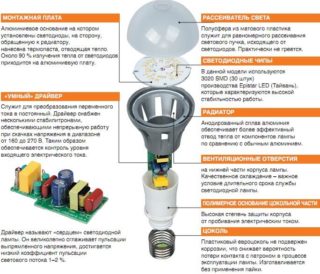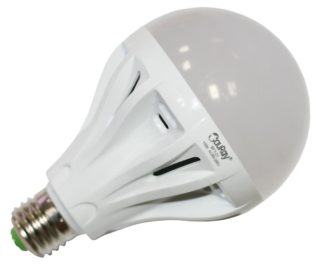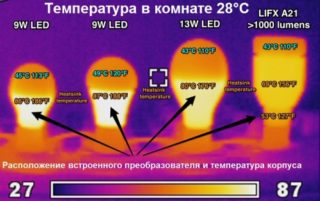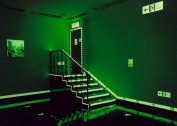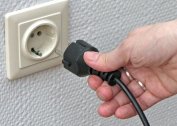Modern LED lamps guarantee a high level of illumination and consume very little energy. The merits of the illuminators are undeniable, but you should find out if the LED bulbs heat up during long-term operation. To do this, you need to understand the design of the devices, and then draw the appropriate conclusions about the order of use.
Features of the design of LED lamps
The design of the products is based on the principle of using a large number of LED chips placed on a special heat-removing substrate. All components are securely covered under a matte translucent hemisphere. In addition to the base, which performs the function of a radiator, the following components and elements are included in the light bulb:
- light diffuser (cap);
- printed circuit board with a set of point LED emitters;
- a radiator used to remove heat from diode crystals;
- electronic control unit - driver;
- lamp base
To get acquainted with the internal parts of the LED lighting fixture, you will need to completely disassemble it by dividing the hemispheres of the cap fastened with reliable latches.
Where does thermal energy come from and where
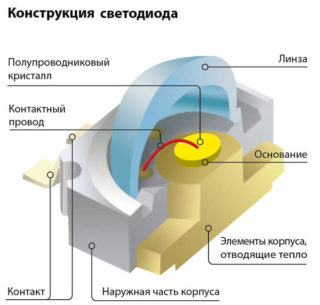 Like most well-known lighting devices, LED analogs have a conversion factor of energy into useful radiated power of less than 100 percent - ranging from 30-40%. The reasons for this are hidden in the features of the device and the functioning of the radiating elements of this class. To understand where the vast majority of energy is spent, you should familiarize yourself with the intricacies of the conversion processes taking place inside the LEDs.
Like most well-known lighting devices, LED analogs have a conversion factor of energy into useful radiated power of less than 100 percent - ranging from 30-40%. The reasons for this are hidden in the features of the device and the functioning of the radiating elements of this class. To understand where the vast majority of energy is spent, you should familiarize yourself with the intricacies of the conversion processes taking place inside the LEDs.
Their work is based on physical principles that are very different from those processes that are observed in fluorescent or conventional incandescent lamps. LED bulbs do not heat up in the truest sense of the word. They do not dissipate thermal energy into the surrounding space, as they spend it on heating the internal crystal of the emitter.
If heat is not deliberately removed from the semiconductor junction, the element crystal under certain conditions risks overheating and then completely burn out. Therefore, the devices that make up high-power LED products need special heat dissipation. The design of LED fixtures with individual bulbs placed in them provides for a special substrate that performs this function. This technique allows with a high degree of probability to keep the LEDs in integrity and extend their service life.
How much the LED crystal heats up
 Usually, the indicator of the heating temperature of the lens of LED elements, which are able to overheat only due to a serious error, is not taken into account with the accuracy that is characteristic of other illuminators. This is explained by the fact that it depends on a number of factors. The most important of them:
Usually, the indicator of the heating temperature of the lens of LED elements, which are able to overheat only due to a serious error, is not taken into account with the accuracy that is characteristic of other illuminators. This is explained by the fact that it depends on a number of factors. The most important of them:
- temperature to which air around the bulb naturally warms up;
- radiator material used to remove heat energy;
- passport power of one light bulb.
The possibility of overheating the crystal depends on the manufacturer that issued the LED, as well as on the quality of its assembly.
The average temperature in the area of the bulb lens ranges from 65 to 70 degrees on the standard Celsius scale.
Which light does not heat up
Lamps that do not produce heat do not exist in nature. This is explained by the physical principle of the formation of light radiation. From the point of view of the classical science of physics, any light bulb is a converter of electrical energy in its variety. In this case, no more than 40 percent of the power taken from the current source is converted into light radiation. Its residues are dissipated in the form of heat into the environment the more, the less the efficiency of this light element.
Three different options are considered and compared as an example:
- The upper zone of a bulb near an incandescent lamp, for example, at 100 watts of power is heated to almost 280 ° C, and the base temperature reaches 70 ° C.
- A compact fluorescent illuminator with a power of 15 W overheats most of all its base - the place where the spiral is located. Its temperature sometimes reaches 130 ° C. At the same time, the heating of the basement in the electronic ballast zone does not exceed 60 ° C.
- In LED lamps, the metal-plastic base of the housing is most significantly heated. For this reason, it is in this place that a radiator is installed that allows you to remove heat from the LEDs and does not allow the bulb to warm up above the permissible norm.
If we consider the issue of the thermal efficiency of the lamps by heating the surrounding space, the LEDs do not belong to “cold” lamps, which in certain situations can be touched with your hands.
Advantages of gentle temperature
Features of heat dissipation from LED lamps, preventing its working parts from being heated above 65-70 degrees, emphasize their advantages over other radiating products. The absence of mercury vapor harmful to the residents of the apartment, as is observed in fluorescent devices, as well as the incomparable life of other lighting fixtures, turn these lamps into a real gift for the user.
The advantage of LED products is that despite the internal heat loss, they still guarantee tangible energy savings.
LED lamps behave best in well-ventilated rooms with artificial (forced) ventilation. And to put such lamps in hot and confined spaces that do not have free access and circulation of air masses means to endanger the product.
Modern lighting devices, built on the basis of LED lamps, belong to the category of relatively new products that need constant monitoring and bringing to condition. As long as this process continues, each user has the opportunity to try out this original new product and test it in various operating modes.
It is impossible to give an unambiguous answer to questions about why some of the energy of the lamps is spent on heat, and whether LED lamps are heated for the home. It all depends on the approach to evaluating the process, which in this case mainly occurs inside the LEDs and only partially extends to the surrounding space.
